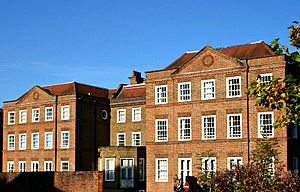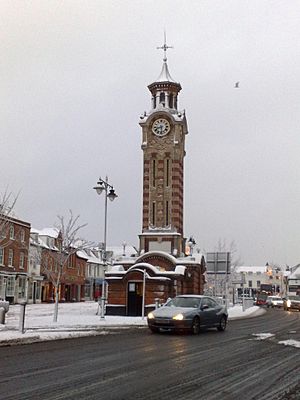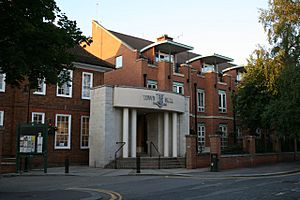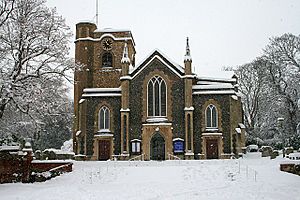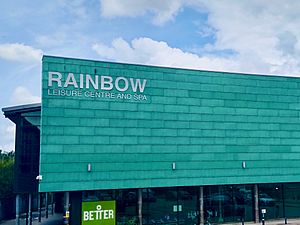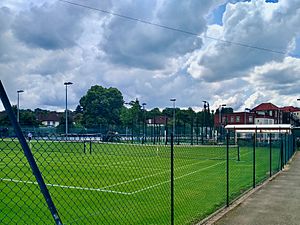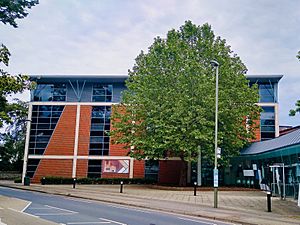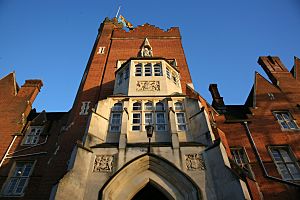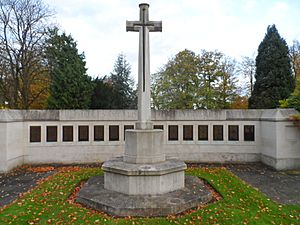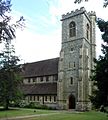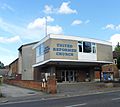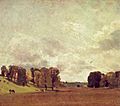Epsom facts for kids
Quick facts for kids Epsom |
|
|---|---|
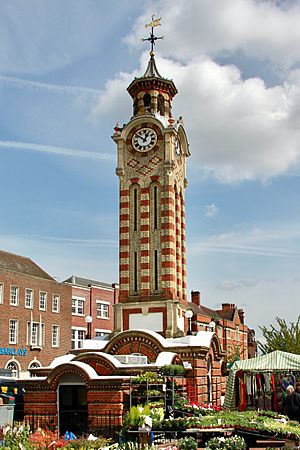 Epsom Clock Tower, High Street |
|
| Area | 18.04 km2 (6.97 sq mi) |
| Population | 31,489 (2011 census) |
| • Density | 1,746/km2 (4,520/sq mi) |
| OS grid reference | TQ2060 |
| District |
|
| Shire county | |
| Region | |
| Country | England |
| Sovereign state | United Kingdom |
| Post town | Epsom |
| Postcode district | KT17, KT18, KT19 |
| Dialling code | 01372 |
| Police | Surrey |
| Fire | Surrey |
| Ambulance | South East Coast |
| EU Parliament | South East England |
| UK Parliament |
|
Epsom is the principal town of the Borough of Epsom and Ewell in Surrey, England, approximately 13.5 mi (21.7 km) south of central London. The town is first recorded as Ebesham in the 10th century and its name probably derives from that of a Saxon landowner. The earliest evidence of human activity is from the mid-Bronze Age, but the modern settlement probably grew up in the area surrounding St Martin's Church in the 6th or 7th centuries and the street pattern is thought to have become established in the Middle Ages. Today the High Street is dominated by the clock tower, which was erected in 1847-8.
Like other nearby settlements, Epsom is located on the spring line where the permeable chalk of the North Downs meets the impermeable London Clay. Several tributaries of the Hogsmill River rise in the town and in the 17th and early 18th centuries, the spring on Epsom Common was believed to have healing qualities. The mineral waters were found to be rich in Epsom salts, which were later identified as magnesium sulphate. Charles II was among those who regularly took the waters and several prominent writers, including John Aubrey, Samuel Pepys and Celia Fiennes recorded their visits. The popularity of the spa declined rapidly in the 1720s as a result of competition from other towns, including Bath and Tunbridge Wells.
Organised horse racing on Epsom Downs is believed to have taken place since the early 17th century. The popularity of Epsom grew as The Oaks and The Derby were established in 1779 and 1780 respectively. The first grandstand at the racecourse was constructed in 1829 and more than 127,000 people attended Derby Day in 1843. During the 1913 Derby, the suffragette, Emily Davison, sustained fatal injuries after being hit by King George V's horse.
The opening of the first railway station in Epsom in 1847, coupled with the breakup of the Epsom Court estate, stimulated the development of the town. Today Epsom station is an important railway junction, where lines to London Victoria and London Waterloo diverge. Since 1946, the town has been surrounded on three sides by the Metropolitan Green Belt, which severely limits the potential for expansion. There are two local nature reserves, Epsom Common and Horton Country Park, to the west of the centre and Epsom Downs, to the south, is a Site of Nature Conservation Importance.
Contents
History

Epsom lies within the Copthorne hundred used for periodic, strategic meetings of the wealthy and powerful in Anglo Saxon England, and later having a Hundred Court. The name of Epsom is early recorded as forms of Ebba's ham (home or perhaps manor). Ebba was a Saxon landowner. Many Spring line settlements by springs in Anglo-Saxon England were founded at the foot of dry valleys such as here and Effingham, Bookham, Cheam, Sutton, Carshalton, Croydon and Bromley. A relic from this period is a 7th-century brooch found in Epsom and now in the British Museum.
Chertsey Abbey, whose ownership of the main manor of Ebbisham was confirmed by King Athelstan in 933, asserted during its Middle Ages existence that Frithwald and Bishop Erkenwald granted it 20 mansas of land in Epsom in 727. Epsom appears in Domesday Book of 1086 as Evesham, held by Chertsey Abbey. Its domesday assets were: 11 hides; 2 churches, 2 mills worth 10 shillings, 18 ploughs, 24 acres (97,000 m2) of meadow, woodland worth 20 hogs; altogether it rendered £17 per year to its overlords. The town at the time of Domesday Book had 38 households (and 6 serfs noteworthy enough to be recorded as assets), some of them in a nucleated village near the parish church of which there were two. At various dates in the Middle Ages manors were founded by subinfeudation at Epsom Court, Horton, Woodcote, Brettgrave and Langley Vale.
Under Henry VIII and Queen Mary the manor passed to the Carew then related Darcy families. It passed via the Mynne, Buckle and Parkhurst families to Sir Charles Kemys Tynte and after his death to Sir Joseph Mawbey.
By the end of the Georgian period, Epsom was known as a spa town. Remnants of this are its water pump and multiple exhibits in the town's museum. There were entertainments at the Assembly Rooms (built c. 1690 and now a pub). A green-buffered housing estate has now been built upon the wells in the south-west of the town.
Epsom salts are named after the town. Epsom salt (magnesium sulphate) was originally prepared by boiling down mineral waters which sprung at Epsom. The town's market is built on the pond that existed in the Middle Ages.
Within the centuries-old boundaries is Epsom Downs Racecourse which features two of the five English Classic horse races; The Derby and The Oaks, which were first run in 1780 and 1779 respectively. On 4 June 1913, Emily Davison, a militant women's suffrage activist, stepped in front of King George V's horse running in the Derby, sustaining fatal injuries.
The British Prime Minister and first chairman of the London County Council, Lord Rosebery, was sent down (expelled) from the University of Oxford in 1869 for buying a racehorse and entering it in the Derby − it finished last. Lord Rosebery remained closely associated with the town throughout his life, leaving land to the borough, commemorated in the names of several roads, Rosebery Park and Rosebery School. A house was also named after him at Epsom College, one of Britain's public schools in Epsom.
The New Student's Reference Work of 1914 describes Epsom:
Ep′som, a small town market of Surrey, England, fifteen miles southwest of London. The springs which made Epsom so fashionable a resort in the latter half of the 17th century, gave name to the Epsom salt, formerly made from them. The church, rebuilt in 1824, contains monuments by Flaxman and Chantrey. On Banstead Downs, one and a half miles south of the town, the most famous horse-races of the world are held yearly on Derby day. The grand stand was built in 1829–30 at a cost of $100,000, and seats 7,500 spectators. Population, 10,915.
Economy and amenities
Epsom Clock Tower was built in 1847, replacing the watchhouse which stood from the 17th century, and was built to 70 feet of red and suffolk brick, with heraldic lions of Caen Stone at the four corners of the tower base. A bell was added in 1867. By 1902 the lions had been replaced by lanterns, (which were replaced by the current globe lights in 1920) and the toilet buildings added either side of the tower.
Owing partly to its position and transport infrastructure in the London commuter belt allowing easy access to the Greater London conurbation to the north and the rolling Surrey countryside to the south, the borough of Epsom and Ewell was named in August 2005 by Channel 4's Location, Location, Location as the "Best Place to Live" in the United Kingdom, and ranked at numbers 8 and 3 in subsequent years.
The Epsom Playhouse was opened in 1984 and is run by Epsom and Ewell Borough council.
The Ashley Centre, a shopping mall, was built in the early 1980s and subsequently parts of the high street were pedestrianised as part of the construction of the town's one-way system. In the 1990s, a large multiplex Odeon cinema was built in Upper High Street.
The late 1990s saw the development of the Ebbisham Centre (not to be confused with the nearby early 18th century Ebbisham House), a community service based development, including a doctors' surgery, Epsom Library, a cafe and a health and fitness centre. The Derby Square expanded and includes a number of franchise chain pubs/bars.
The University for the Creative Arts has one of its five campuses in Epsom. Laine Theatre Arts, an independent performing arts college, is based in the town. Students have included Victoria Beckham. Leisure facilities in and around the town include a leisure centre (the Rainbow Centre) on East Street; Epsom Downs Racecourse; the Odeon cinema; and the Horton Park Children's Farm.
Major employers in the town include Epsom and Ewell Borough Council and WS Atkins.
As part of Epsom and Ewell, the town is twinned with Chantilly in northern France. Epsom and Ewell was ranked in the top ten of the Halifax Quality of Life Survey 2011.
Sport
Rainbow Leisure Centre
The current Rainbow Leisure Centre opened in 2003, replacing the original facility which dated from the 1930s. The centre includes swimming pools, two dance studios and a sports hall with four badminton courts. In 2011, a spa facility was added as part of an extensive refurbishment, during which the gym equipment was also upgraded. The centre is managed by Greenwich Leisure Limited (GLL) under their "Better" brand.
Association Football
Epsom & Ewell F.C. traces its origins to the Epsom Juniors Cricket Club, founded in March 1918. A year later the team began to play football and was a founder member of the Sutton & District League in 1920. The team changed its name to Epsom Town F.C. in 1922 and played its home games at the Horton Hospital Sports Ground. The club became Epsom F.C. in 1934 and adopted its current name in 1960. Since the start of the 2020/21 season, the club has been based at Fetcham Grove, the Leatherhead F.C. stadium.
Cricket
The earliest reference to cricket being played in the town is from 1711 and Epsom Cricket Club is thought to have been founded in around 1800. During the early 19th century, matches appear to have taken place on the Downs and also at Stamford Green on Epsom Common. By 1860, the club had established a new ground on Woodcote Road, on land belonging to Edward Richard Northey, and plays its home games there today.
Hockey
Epsom Hockey Club is thought to have been founded in around 1900 and was well established by the 1909/10 season. Initially, home games were played at the Court Recreation Ground, but the club established a permanent base in Woodcote Road after the Second World War.
Tennis
Epsom Lawn Tennis Club was founded as a croquet club in the 1850s, based at Woodcote House. By the 1870s, tennis became the more important sport and in 1913 the club had five tennis courts and three croquet courts. The last remaining croquet court was converted to a grass tennis court in 1923.
Other sports
Epsom and Ewell Harriers is a club for track and field athletes, based at the Poole Road Track in Ewell. Epsom Cycling Club was founded in 1891 and is one of the oldest in the country. The club arranges organised rides and regular time trials in the local area. Sutton and Epsom Rugby Football Club was founded in 1881 and their main ground is at Rugby Lane, Cheam.
Geography
Soil and elevation
The town is bisected in two in terms of soil: the north of the town is on gravel and sand deposited around the London Clay of most of London as the Thanet Formation, whereas the south-east of the town is on uneroded chalk slopes: Epsom Downs refers to these slopes reaching up to wide plateau (on which sit the formerly water-scarce settlements: Box Hill, Walton on the Hill, Tadworth and Kingswood, Surrey) and covers 990 acres (400 ha) of what is in traditional terms and in technical terms, part of the area of the settlement, called Epsom Downs. In terms of topsoil, the northern soil is free draining, slightly acid but base-rich soils, producing extremely fertile pastures and deciduous woodland. The southern soil is of two types:
- shallow, lime-rich soil over chalk or limestone of the escarpment
- slightly acid, loamy and clayey soils with impeded drainage soil
The town's clustered bulk is at 35m to 70m (above Ordnance Datum, mean sea level) and slopes incrementally from south and all other directions (to a lesser extent) towards the centre-north. The racecourse and Langley Vale parts of Epsom rise to high points of 140m and form a drainage divide between tributaries of the Thames flowing north and towards the Mole Gap south-west.
Nearest settlements
 |
Hook West Ewell, Ewell |
Ewell | Cheam Sutton |
 |
| Chessington | Banstead | |||
| Ashtead | Walton on the Hill | Tattenham Corner |
Demography and housing
In the 2011 Census, the combined population of the College, Court, Stamford, Town and Woodcote wards was 31,489.
| Ward | Population | Households | % Owned outright | % Owned with a loan | hectares |
|---|---|---|---|---|---|
| College | 5,873 | 2,248 | 41.1 | 35.9 | 316 |
| Court | 6,830 | 2,567 | 13.8 | 39.8 | 213 |
| Stamford | 6,088 | 2,348 | 38.5 | 43.7 | 436 |
| Town | 6,979 | 3,154 | 27 | 29.1 | 136 |
| Woodcote | 5,719 | 2,286 | 41.4 | 37.9 | 703 |
| Regional average | 35.1 | 32.5 |
| Ward | Detached | Semi-detached | Terraced | Flats and apartments | Caravans/temporary/mobile homes/houseboats | Shared between households |
|---|---|---|---|---|---|---|
| College | 1,040 | 425 | 144 | 622 | 0 | 17 |
| Court | 160 | 721 | 947 | 738 | 1 | 0 |
| Stamford | 707 | 995 | 300 | 346 | 0 | 0 |
| Town | 237 | 849 | 455 | 1,584 | 2 | 27 |
| Woodcote | 1,111 | 513 | 232 | 430 | 0 | 0 |
Localities
Epsom is contiguous apart from the neighbourhoods or localities below.
Horton
Horton covers the slightly elevated westernmost part of the borough. Suburban and rural, it is centred on Horton Lane, a wide road with gentle bends, 1.5 miles (2.4 km) in length with a 40 mph speed limit one of two routes between Chessington (including Hook) and the West Ewell-Epsom conurbation as an alternative route to Hook Road (the B284). It was a manor of the parish and remains a hamlet of the town as well as not qualifying for post town status. The place-name Horton is a common one in England. It derives from Old English horu 'dirt' and tūn 'settlement, farm, estate', presumably meaning 'farm on muddy soil'. Formerly around it were a group of psychiatric hospitals which served London and Surrey, forming a socially distanced community and pre-dated the United Kingdom's shift to care in the community mental health treatments which commenced in the early 20th century.
Horton's amenities include:
- Horton Park Golf Club
- David Lloyd Leisure Centre
- Horton Country Park
- Hobbledown children's adventure park and farm
- Epsom Polo Club
Langley Vale
This locality is a sloped, developed network of streets, surrounded by steep farmland and the racecourse.
Transport
Bus
Epsom is linked by a number of bus routes to surrounding towns and villages in north Surrey and south London. Operators serving the town include Falcon Buses, London United and Metrobus.
Train
Epsom railway station is a short distance to the north of the town centre and is managed by Southern. The current station building was opened in 2013, following a three-year, £20M redevelopment. It is served by trains to London Victoria and London Bridge via Sutton, to London Waterloo via Wimbledon, to Horsham via Dorking and to Guildford via Bookham.
Long-distance footpath
The Thames Down Link long distance footpath between Kingston upon Thames and Box Hill runs through Horton Country Park and across Epsom Common.
Education
Further and Higher Education
The Epsom campus of the University for the Creative Arts was founded as the Epsom Technical Institute & School of Art in 1896. The original building in Church Street was designed by John Hatchard-Smith in the English Renaissance style and was financed by public subscription. It moved to new premises in Ashley Road in 1973 and merged with the West Surrey College of Art and Design to form the Surrey Institute of Art and Design in 1994. The combined institution was granted university college status in 1999. In 2005, it merged with the Kent Institute of Art and Design to become the University for the Creative Arts.
Laine Theatre Arts is an independent performing arts college, founded by Betty Laine in 1974. It prepares students for careers in professional musical theatre and teaches the core skills of dance, singing and acting. Alumni include Victoria Beckham, Kerry Ellis, Ben Richards and Sarah Hadland.
Maintained schools
Blenheim High School opened in 1997 and it became an academy in 2012.
Glyn School was founded as the Epsom County School in 1927 and became a grammar school in 1944. It was renamed Glyn Grammar School in 1954, after Sir Arthur Glyn, the first chairman of the school Governing Body. It became a comprehensive school in 1976 and its name changed again to Glyn/ADT School of Technology in 1994. The school gained academy status in 2011.
Rosebery School was opened in 1921 as the Epsom County Secondary School for Girls. In 1927, it moved to its current site on land donated by Lord Rosebery, acquiring its present name at the same time. It became an academy in 2011.
Independent schools
Epsom College was founded in 1851 as the Medical Benevolent College by the physician, John Propert. The school buildings were opened in 1855 by Prince Albert and the first cohort of 100 pupils were all sons of medics. By 1865, the school roll had grown to 300 and had been opened to those able to pay fees. The Grade II-listed chapel, dedicated to St Luke, was built in 1857 and was enlarged by Arthur Blomfield in 1895. Girls were first admitted to the school in 1976 and Epsom College became fully coeducational in 1996.
Kingswood House School is a preparatory school to the west of the town centre. It was founded in 1899 and moved to its present site on West Hill in 1920. Since the 1960s it has operated exclusively as a day school. Girls will be admitted for the first time in September 2021.
Notable buildings and landmarks
The Ashley Centre
Construction of The Ashley Centre was proposed in the late 1970s, following concerns that retail sector of the local economy was in decline. The shopping centre was designed by Humphrey Wood and the building makes extensive use of steel, glass and marble. A multistorey car park and an office block were included in the scheme, in addition to 23,000 m2 (250,000 sq ft) of retail space. The Centre was opened by Queen Elizabeth II on 24 October 1984 and is named after the adjacent Ashley Road.
Ashley House
Ashley House is named after Mary Ashley, a former resident who lived at the property until 1849. The three-storey, brick townhouse was constructed in the late 1760s and is protected by a Grade II* listing. It features an Adam-style central doorcase with a composite Tower of the Winds and Ionic columns.
Assembly Rooms
The Assembly Rooms building was constructed in around 1692, when the spa was at the height of it popularity. It functioned as a meeting place and included a tavern, coffee house and billiard room. A bowling green and a cockpit, in which fighting cocks were set against each other for sport, were also part of the same complex. Following the decline of the spa in the first half of the 18th century, much of the building was converted to shops and to housing for private families. Since April 2002, the Assembly Rooms has operated as a public house, owned by Wetherspoons.
Clock Tower
The foundation stone for the Clock Tower was laid in November 1847, following the demolition of the watch house which had stood on the site from the 17th century. The 70 ft-tall (21 m) tower, designed by James Butler and Henry Hodge, is constructed from red and grey brick with ashlar dressings. Initially four lion sculptures made of Caen stone were positioned at each corner of the base, however by 1902 they had been replaced by electric lanterns, which were replaced, in 1920, by the current globe lights. In the same year, the base of the tower was extended to the east and west to provide toilet facilities. Several public events and civic ceremonies have taken place in the area at the base of the tower, including the official granting of the foundation charter of the Borough of Epsom and Ewell in September 1937.
Spread Eagle Walk
The Spread Eagle Walk shopping centre was constructed as a coaching inn in the late 17th century. The main hotel building has two storeys with an attic and basement. The external stucco finish and sash windows are later additions. The distinctive black eagle sculptures above the two porticos are thought to date from the mid-late 19th century. The inn traded as a public house until around 1990, when it closed for renovation. The driveway into the former stables was converted into the main entrance to the shopping centre and in 1994 the main building was occupied by Lester Bowden outfitters, which had been founded by Arthur Bowden at start of the 20th century.
Town Hall
The neo-Georgian Epsom Town Hall, designed by Hubert Moore Fairweather and William Alfred Pite, was opened in 1934. The building has served as the headquarters of Epsom Urban District Council (UDC), Epsom Borough Council and, since 1974, Epsom and Ewell Borough Council. The New Town Hall was opened in 1992 and is connected to the older building by covered walkways.
War memorials
Epsom War Memorial at Epsom Cemetery was erected in 1921 to commemorate the 256 residents of Epsom and Ewell who had died in the First World War. The memorial consists of a Celtic cross in granite and the gates are dedicated to the 18th, 19th, 20th and 21st Battalions of the Royal Fusiliers, who were billeted in Epsom before the opening of the Woodcote Park camp. Following the end of the Second World War, an additional inscription was added to commemorate those who had died between 1939 and 1945.
The Commonwealth War Graves Memorial was erected in Epsom Cemetery in 1925. It consists of a cross, behind which is a screen wall on which names of 148 Commonwealth soldiers are inscribed. The majority of those commemorated died in the hospitals of the Epsom Cluster.
Woodcote Park
Woodcote Park was created as a hunting park in the mid-12th century by the abbot of Chertsey Abbey. Following the Dissolution of the Monasteries in the mid-16th century, the park was briefly held by Sir Nicholas Carew, before being annexed to the Honour of Hampton Court. In the mid-17th century, the land was inherited by Elizabeth Mynne, wife of Richard Evelyn, for whom the first mansion house was constructed. The building included decorative features by the sculptor, Grinling Gibbons, and a ceiling by the painter, Antonio Verrio. In 1715, the estate was inherited by Charles Calvert, 5th Baron Baltimore, who commissioned Isaac Ware to rebuild the mansion in the French Rococo Revival style. Some of the features of the original house were reused, including the Verrio ceiling. Shortly before his death, Calvert engaged John Vardy to design a Palladian stone frontage.
Following long periods of ownership by the Tessier and Brooks families during the 19th century, the Royal Automobile Club (R.A.C.) purchased Woodcote Park in 1913. Many of the historic interiors were not required by the R.A.C. and were removed and sold at auction. In 1927, wood panelling and other decorations in the style of Thomas Chippendale, from one of the drawing rooms, were installed in the Museum of Fine Arts at Boston, Massachusetts. The mansion was destroyed by fire in August 1934, but within two years had been rebuilt with an identical exterior appearance. Today the 350-acre (140 ha) site features two 18-hole golf courses, sports and spa facilities, as well as restaurants and guest accommodation. The club also houses a fleet of heritage motor vehicles, owned by the R.A.C.
Images for kids
-
Diomed by John Nost Sartorius (1755-1828). Diomed was the winner of the first Derby in 1780.
-
The Great Pond, Epsom Common
-
Nilgai at Hobbledown Children's Farm, Horton Country Park
See also
 In Spanish: Epsom para niños
In Spanish: Epsom para niños




